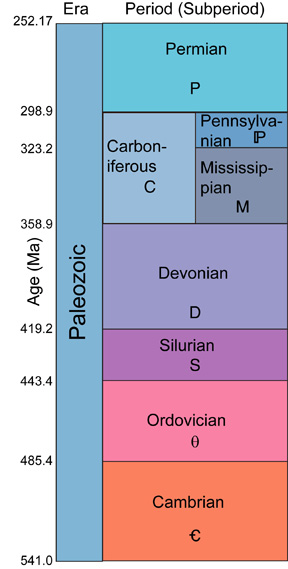GEOL 102 Historical Geology
Spring Semester 2012
The Early Paleozoic I: Cambrian Geology
So now we are at the Phanerozoic:
:

Starting with the Paleozoic:

Phanerozoic Eon: 542 - 0 Ma
Paleozoic Era: 542 - 252.3 Ma
Base of Cambrian (and thus of the Paleozoic, and Phanerozoic):
- Historically, the first appearance of macroscopic shelly fossils (the
Cambrian Explosion)
- At present, first appearance of burrowing trace fossil
Trichophycus pedum (formerly Phycodes pedum), very likely the burrows of priapulid worms
- This event is dated radiometrically at about 542 Ma, and is thus older (by about 15
million years or more) than the "Cambrian Explosion" proper
The "Long Fuse" of the Cambrian Explosion:
- Fortunian Age (once "Manykaian Age", first part of Terrenuevian Epoch): first good infaunal trace fossils, some rare calcareous fossils
- Cambrian Age 2 (formerly "Tommotian Age", second part of Terreneuvian Epoch):
- Small Shelly Fauna or (SSFs):
- c. 1-3 mm long
- Various calcareous (also some silica, some calcium phosphate) fossils
- Represent a variety of organisms: sponges, mollusks, annelids, possible brachiopods
- Archaeocyathids:
- Main Early Cambrian reef formers, probably a type of sponge
- Cone-in-cone structure, calcareous skeleton
- Small (few cms tall)
- 1rst appear in "Tommotian"; die off at end of Cambrian Epoch 2
- Cambrian Age 3 (formerly "Atdbanian Age", first part of Cambrian Epoch 2): The Cambrian Explosion proper:
- Appearance of macroscopic calcareous (and silica and calcium phosphate) hard parts
across the Tree of Life, especially within Lophotrochozoa (in brachiopods and mollusks),
Ecdysozoa (in arthropods), and in Deuterostomia (in echinoderms and
vertebrates)
- Because these groups are either known or inferred to have been present earlier in the Cambrian (or even
Ediacaran), the Cambrian Explosion is now known to have NOT been the sudden origin of these groups. Instead,
it appears to be a biogeochemical event: a time when conditions were such that biomineralization became easier
for animals, and many different already-existing lineages could take advantage of it. (That doesn't mean that there
isn't a big diversification because of it: after all, being able to make skeletons was extremely useful and there
are adaptative radiations because of it. But it does mean that the groups themselves had a long history already.)
More on Cambrian life later.
The Cambrian Substrate Revolution
Evidence for microbial matgrounds in shallow marine sediments (siliciclastic & carbonate)
during Neoproterozoic:
- Layers well laminated, almost no vertical bioturbation
- Water-Sediment interface probably very sharp
- Postulated
ecohabits include: mat scratchers, mat miners, mat stickers, mat encrusters
During Cambrian, rise of some bioturbators, with limited vertical mining abilities.
Presence of surviving mat scratchers (diverse ancestral mollusks, esp. diverse
monoplacophorans and polyplacophorans), and some probable mat-sticking echinoderms
(helioplacoids). As rise of deeper burrowers and grazing increases in late Cambrian,
increasingly Phanerozoic-style substrates:
- Poorly laminated sediments in shallow water
- Water-Sediment interfaced blurred and "soupy"
- Extinction of taxa like
helioplacoids that attached directly to hard sediment-water interface;
migration of mat
scraters and mat miners upwards (to rocky shores) or downwards (to deep water)
Paleogeography and Tectonics of
the Cambrian
Pannotia (supercontinent) breaks apart at or near the base of the Cambrian. Breaks up into:
- Gondwana (modern South America, Africa, Madagascar, India, Antarctica, Australia,
and assorted fragments): mostly emergent in Cambrian
- Laurentia (modern North America (except for far west) and Greenland); mostly submerged by end of Cambrian
- Separeted from Baltica and Gondwana by Iapetus Ocean
- Baltica (much of modern western and northern Europe): mostly submerged
- Separated from Gondwana by Tornquist Sea, from Siberia by Paleo-Asian Ocean
- Siberia (much of northwestern Asia)
- various Asian blocks: all mostly submerged
Global (eustatic) transgressions in Middle & Late Cambrian:
- In western Laurentia, huge onlap sequences (the Tonto Group exposed from California to the Grand Canyon)
- Across much of world, very large cabonate banks form
Paleogeography and Geology of the Ordovician:
Gondwana moves poleward
During Late Ordovician, major
(but brief) glaciations.
In eastern Laurentia, Early & Middle Ordovician huge stable carbonate platform
(continuation of Cambrian).
During Middle-Late Ordovician,
the Taconic Orogeny (first of the Appalachian orogenies):
- Small microcontinent (or "exotic terrane") Avalonia breaks off from
Gondwana, travels through Iapetus (proto-Atlantic) Ocean
- Volcanic arc produced as Avalonia comes close to eastern Laurentia, producing giant
ash marker bed (the Millbrig Bed of North America, the Big Bentonite of
western Europe)
- In eastern Laurentia, major down drop of foreland basin generates thick flysch and
thicker molasse ("clastic wedge") deposits extend far into inland seas of Laurentia.
Collision and suturing between Avalonia and Laurentia possible in northern part of
Appalachian region; however, still seem to have been separate further south.
Glaciers at end of Ordovician produce pulses of extinction.
To Next Lecture.
To Previous Lecture.
To Syllabus.
Last modified: 9 January 2012



